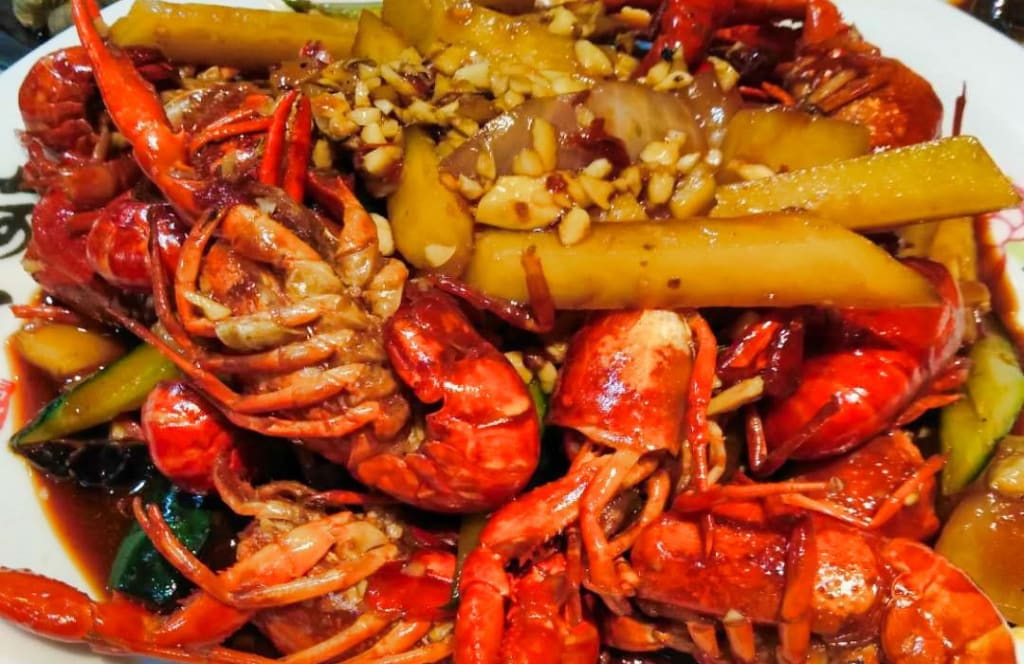Xiaolongxia: On Chinese Crayfish
They're not just a Louisiana specialty.

If you've lived or traveled anywhere close to the American South, you're likely familiar with crayfish, the tiny crustaceans that creep around the bottoms of freshwater lakes in the American interior. Cheaper and easier to find than lobsters, their bigger cousins, they are a signature element of Cajun cuisine. Stroll through New Orleans on a summer night and you'll see pots full of steamed crayfish served with potatoes and cornbread.
We tend to associate crayfish with Louisiana, and not without reason given that such a large proportion of the world's supply is harvested there. However, crayfish pop up in other world cuisines. They are an important part of the traditional Scandinavian diet, particularly in Finland. Crayfish also have a part in the storied histories of Spanish and French cuisine.
The above picture was taken in a place less associated with crayfish: Central China. Crayfish (xiaolongxia - literally "little lobster") are an important part of regional cuisine in certain parts of the country, particularly in Anhui province. Walk down the right street on the right night in Hefei, and you'd be forgiven for thinking that you'd been transported to the Big Easy, with those familiar pots of freshly cooked crayfish.
Crayfish are available year-round, but the best time to eat them is in the summer months. They are traditionally consumed outdoors along with beer (eating crayfish with alcohol being common in many cultures which serve them). Crayfish are often served as the central dish in Chinese barbecue, preceded by grilled lamb or beef, roasted greens, mushrooms and peanuts - all heavily spiced in the mala tradition. Xiaolongxia are not for those cursed with a sensitive palate.
But that's not the only way that xiaolongxia are served - go to any city where crayfish are a key food and you'll find them sneaking into other dishes. Xiaolongxia come in different qualities, with only the best ones set aside to be steamed whole. Lesser crayfish are ground up and made into meatballs, which maintain the taste but are far less spicy. Go to a baozi stand in the morning and you might find steamed buns with xiaolongxia filling on the menu.
Even so, anyone who travels to one of the crayfish hot spots should try to find a place where they're served in the traditional fashion. Some cities have a xiaolongxia district, where every restaurant specializes in crayfish. The crayfish streets are easy to spot by their decor - if you look around and every building has a giant cartoon crustacean on its facade, then you've found it.
Just because you've found a xiaolongxia restaurant doesn't mean you should ramble on in - this is one area where having local friends really pays off. Your Chinese friends will have a better idea as to which restaurants are the best - remember, xiaolongxia come in many grades, and it takes a local to know which places serve the best ones.
A local can also help you place your order - and help you avoid getting the foreigner's discount. Xiaolongxia are not terribly expensive, but the price can vary a lot based on time and place as well as what other dishes you order. An order of crayfish for a few people will cost about $7, but a full dinner - with the barbecue and beer and the other accoutrements - might run from $10-$25 per person, depending on how extravagant you want to go.
Crayfish are, of course, only the tip of the iceberg when it comes to seafood in Chinese cuisine, but in certain parts of the country they are culturally significant. Should you find yourself in central China, take at least one evening to enjoy a pot of xiaolongxia. If nothing else, it should be a memorable meal.
I hope you found this little article of mine interesting. If you really want to be a friend, you can help me out cost-free by checking out my ongoing serial novel.
About the Creator
Andrew Johnston
Educator, writer and documentarian based out of central China. Catch the full story at www.findthefabulist.com.






Comments
There are no comments for this story
Be the first to respond and start the conversation.